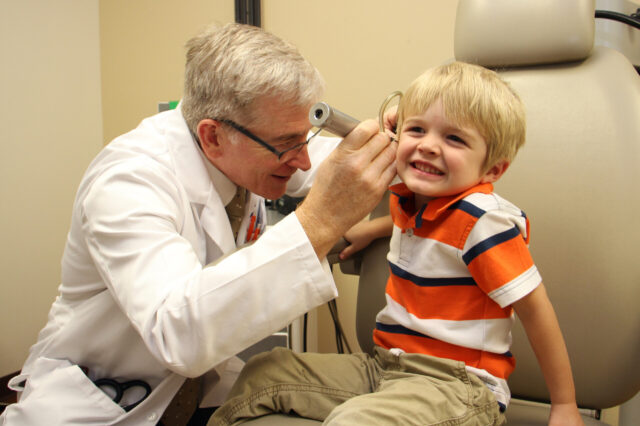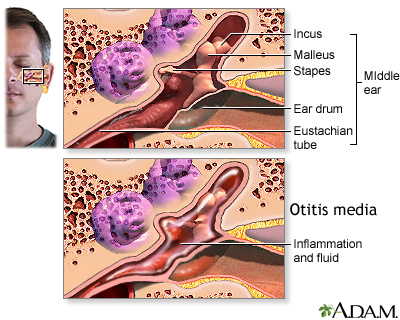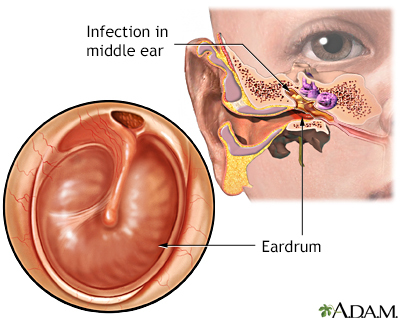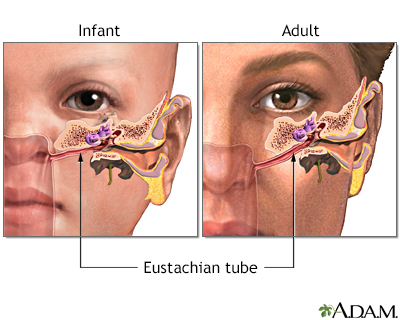Definition
Chronic ear infection is fluid, swelling, or an infection behind the eardrum that does not go away or keeps coming back. It causes long-term or permanent damage to the ear. It often involves a hole in the eardrum that does not heal.
Alternative Names
Middle ear infection - chronic; Otitis media - chronic; Chronic otitis media; Chronic ear infection
The eustachian tube runs from the middle of each ear to the back of the throat. This tube drains fluid made in the middle ear. If the eustachian tube becomes blocked, fluid can build up. When this happens, infection can occur. A chronic ear infection develops when fluid or an infection behind the eardrum does not go away.
A chronic ear infection may be caused by:
- An acute ear infection that does not completely go away
- Repeated ear infections
"Suppurative chronic otitis" is a term used to describe an eardrum that keeps rupturing, draining, or swelling in the middle ear or mastoid area and does not go away.
Ear infections are more common in children because their eustachian tubes are shorter, narrower, and more horizontal than in adults. Chronic ear infections are much less common than acute ear infections.
Symptoms
Symptoms of a chronic ear infection may be less severe than symptoms of an acute infection. The problem may go unnoticed and untreated for a long time.
Symptoms may include:
Symptoms may continue or come and go. They may occur in one or both ears.
Exams and Tests
Your health care provider will look in the ears using an otoscope. The exam may reveal:
- Dullness, redness in the middle ear
- Air bubbles in the middle ear
- Thick fluid in the middle ear
- Eardrum that sticks to the bones in the middle ear
- Draining fluid from the eardrum
- A hole (perforation) in the eardrum
- An eardrum that bulges out or pulls back inward (collapses)
Tests may include:
- Cultures of the fluid that may show a bacterial infection.
- A CT scan of the head or mastoids may show that the infection has spread beyond the middle ear.
- Hearing tests may be needed.
Treatment
The provider may prescribe antibiotics if the infection is caused by bacteria. These medicines may need to be taken for a long time. They can be given by mouth or into a vein (intravenously).
If there is a hole in the eardrum, antibiotic ear drops are used. The provider may recommend using a mild acidic solution (such as vinegar and water) for a hard-to-treat infected ear that has a hole (perforation). A surgeon may need to clean out (debride) tissue that has gathered inside the ear.
Other surgeries that may be needed include:
- Surgery to clean the infection out of the mastoid bone (mastoidectomy)
- Surgery to repair or replace the small bones in the middle ear
- Repair of the eardrum
- Ear tube surgery
Outlook (Prognosis)
Chronic ear infections often respond to treatment. However, your child may need to keep taking medicines for several months.
Chronic ear infections are not life threatening. However, they can be uncomfortable and may result in hearing loss and other serious complications.
Possible Complications
A chronic ear infection may cause permanent changes to the ear and nearby bones, including:
- Infection of the mastoid bone behind the ear (mastoiditis)
- Ongoing drainage from a hole in the eardrum that does not heal, or after ear tubes are inserted
- Cyst in the middle ear (cholesteatoma)
- Hardening of the tissue in the middle ear (tympanosclerosis)
- Damage to, or wearing away of the bones of the middle ear, which help with hearing
- Paralysis of the face
- Inflammation around the brain (epidural abscess) or in the brain
- Damage to the part of the ear that helps with balance
Hearing loss from damage to the middle ear may slow language and speech development. This is more likely if both ears are affected.
Permanent hearing loss is rare, but the risk increases with the number and length of infections.
Prevention
Getting prompt treatment for an acute ear infection may reduce the risk of developing a chronic ear infection. Have a follow-up exam with your provider after an ear infection has been treated to make sure that it is completely cured.
References
Chole RA, Sharon JD. Chronic otitis media, mastoiditis, and petrositis. In: Flint PW, Francis HW, Haughey BH, et al, eds. Cummings Otolaryngology: Head and Neck Surgery. 7th ed. Philadelphia, PA: Elsevier; 2021:chap 140.
Ironside JW, Smith C. Central and peripheral nervous systems. In: Cross SS, ed. Underwood's Pathology. 7th ed. Philadelphia, PA: Elsevier; 2019:chap 26.
Kerschner JE, Preciado D. Otitis media. In: Kliegman RM, St. Geme JW, Blum NJ, Shah SS, Tasker RC, Wilson KM, eds. Nelson Textbook of Pediatrics. 21st ed. Philadelphia, PA: Elsevier; 2020:chap 658.
Pelton SI. Otitis externa, otitis media, and mastoiditis. In: Bennett JE, Dolin R, Blaser MJ, eds. Mandell, Douglas, and Bennett's Principles and Practice of Infectious Diseases. 9th ed. Philadelphia, PA: Elsevier; 2020:chap 61.
Rosenfeld RM, Schwartz SR, Pynnonen MA, et al. Clinical practice guideline: Tympanostomy tubes in children. Otolaryngol Head Neck Surg. 2013;149(1 Suppl):S1-S35. PMID: 23818543 pubmed.ncbi.nlm.nih.gov/23818543/.
Rosenfeld RM, Tunkel DE, Schwartz SR, et al. Clinical Practice Guideline: Tympanostomy tubes in children (update). Otolaryngol Head Neck Surg. 2022;166(1_suppl):S1-S55. PMID: 35138954 pubmed.ncbi.nlm.nih.gov/35138954/.
Steele DW, Adam GP, Di M, Halladay CH, Balk EM, Trikalinos TA. Effectiveness of tympanostomy tubes for otitis media: a meta-analysis. Pediatrics. 2017;139(6):e20170125. doi:10.1542/peds.2017-0125. PMID: 28562283 pubmed.ncbi.nlm.nih.gov/28562283/.






